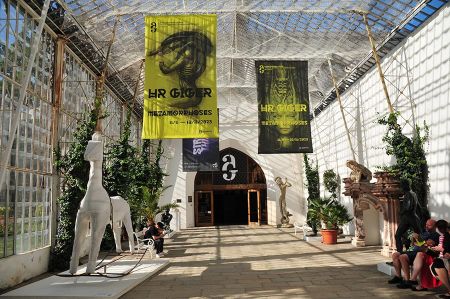Madonna of Rudolfov in the South Bohemian Aleš Gallery
- Written by Portal Editor
We were to encounter another surprise during our visit to the Aleš Gallery in Hluboká nad Vltavou, which has nothing to do with works by HR Giger, but was made a long time ago and was consecrated as early as 1274 in the Dominican Church in České Budějovice : Madonna by Rudolfov.
The Rudolfov Madonna is one of the most valuable monuments of early Gothic sculpture in Bohemia, which probably dates from the end of the reign of Ottokar II of Bohemia. The Madonna is on display in the permanent exhibition of the South Bohemian Aleš Gallery in Hluboká nad Vltavou and there is an interesting connection to Naumburg and Magdeburg.
Orientation on the stone sculptures of the cathedrals of Reims and Amiens
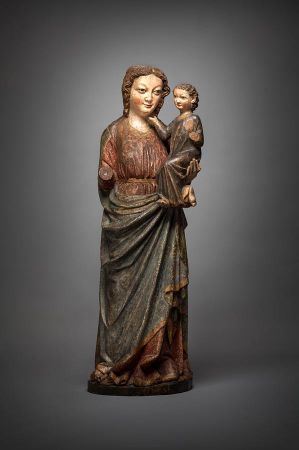 A statue of Rudolfov's Madonna is made of fir-wood, hollowed out at the back and with preserved original polychrome of the face. The monumental and static conception of the statue is based on the stone sculptures of the French cathedrals of Reims and Amiens, whose style also spread to German countries in the 13th century.
A statue of Rudolfov's Madonna is made of fir-wood, hollowed out at the back and with preserved original polychrome of the face. The monumental and static conception of the statue is based on the stone sculptures of the French cathedrals of Reims and Amiens, whose style also spread to German countries in the 13th century.
Rudolfov's Madonna is related to the Saxon-Thuringian area, especially the Magdeburg and Naumburg districts. This relationship corresponds to the style of draping on the right side of the figure, the arrangement of the folds at the bottom hem of the cloak, and the organic conception of the relationship between body and garment. The dress is girded with a gold belt, which emphasizes the plasticity of the body and creates regular vertical folds on the breasts.
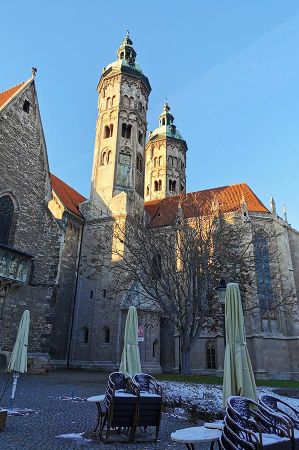 The now Protestant Naumburg Cathedral of St. Peter and Paul in Naumburg (Saale) is the former cathedral of the Naumburg diocese and largely dates from the first half of the 13th century. It is one of the most important late Romanesque buildings in Saxony-Anhalt, is a stop on the Romanesque Road and has been a UNESCO World Heritage Site since 2018. The Marienpfarrkirche is located southwest of the cathedral on the south wing of the cloister. The previous building was partially excavated, but its age is still undetermined.
The now Protestant Naumburg Cathedral of St. Peter and Paul in Naumburg (Saale) is the former cathedral of the Naumburg diocese and largely dates from the first half of the 13th century. It is one of the most important late Romanesque buildings in Saxony-Anhalt, is a stop on the Romanesque Road and has been a UNESCO World Heritage Site since 2018. The Marienpfarrkirche is located southwest of the cathedral on the south wing of the cloister. The previous building was partially excavated, but its age is still undetermined.
The choir and remains of the outer walls of a new High Gothic building, which was documented as having been occupied in 1343, have been preserved. The church was probably founded together with the episcopal church as the parish church of the cathedral community. In 1329 it was given to the cathedral chapter for free use. After the fire of 1532 it remained in ruins. The room that now serves as a winter church was only built as a gymnasium in place of the nave around 1900. As part of the 2011 state exhibition, St. Mary's Church also received an organ. But now back to Rudolfov's Madonna.
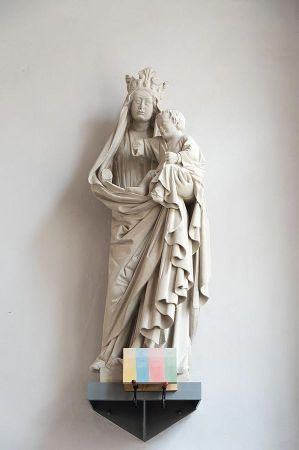 The folds of the cloak, which run from the shoulders to the floor, converge on the left side towards the child Jesus, who thus forms the ideological focus of the sculpture.
The folds of the cloak, which run from the shoulders to the floor, converge on the left side towards the child Jesus, who thus forms the ideological focus of the sculpture.
The Madonna leans towards the baby Jesus on her left side and her slightly bent right free leg with the outstretched toe protrudes from under the robe. The gesture of the Child Jesus stroking his mother's chin with his right hand is of Byzantine origin.
Not only is it an expression of childish playfulness, but it points to the Virgin Mary as a mediator of grace and could be a representation of Christ's statement on the cross: “Behold your mother,” which refers to his redemptive death. The child's bare feet are also symbolic, pointing to Christ's later sacrifice.
Location and classification of the figure
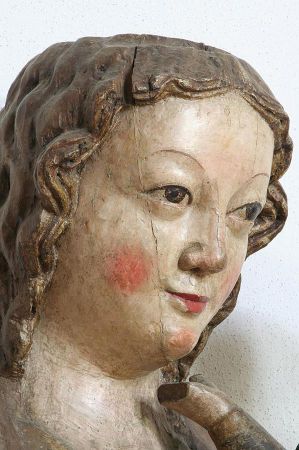 The statue was found in 1937 by Vladimír Denkstein in the former Lutheran church in Rudolfov. Unfortunately, parts of the Madonna's right hand, which presumably held the sceptre, the baby Jesus' left hand, and the veil that covered part of the Madonna's head were missing.
The statue was found in 1937 by Vladimír Denkstein in the former Lutheran church in Rudolfov. Unfortunately, parts of the Madonna's right hand, which presumably held the sceptre, the baby Jesus' left hand, and the veil that covered part of the Madonna's head were missing.
A groove can be seen around the cut top of the statue, which was probably notched for the crown. The height of the statue is 141 cm.
The original polychrome of the robe, some of which has been preserved under later layers of paint, was completely different because Mary wore a purple dress with a gold trim on the neckline and a blue cloak with green lining, while Jesus wore a coral red shirt.
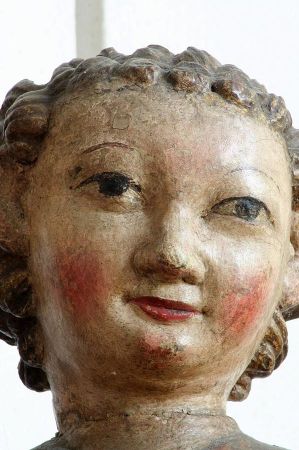 The statue was restored by Prof. Bohuslav Slánský in 1946–1948.
The statue was restored by Prof. Bohuslav Slánský in 1946–1948.
As is often the case, opinions differ widely about the date of the work.
Based on some formal features (the cup-shaped folds of the robe on the right side), the work can be dated to the end of the 13th century, but the gesture of the child Jesus (identical to the Madonna of Strakonice) refers to the end of the 13th century new style characterized by verticality and dematerialization.
Please read as well:
